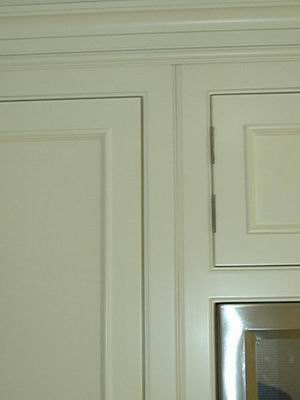Checking a Steel Square for Squareness
The simple method explained, with some additional discussion. April 24, 2014
Question
WOODWEB Member:
What do you use as a benchmark for square? In other words, what do use to check the squareness of your squares? Reason I ask is some of my squares are out with others and I don't know which to believe. I'm thinking a factory fresh piece of MDF would tell the truth.
Forum Responses
(Cabinetmaking Forum)
From contributor M:
If you have a CNC, slider, or other piece of equipment that you know is cutting square, you could cut a square corner on a piece of sheet good.
From contributor D:
If you are talking about that MDF sheet being actually square, you cannot expect that at all. The edges may be straight and you can use one to test the square. Even the new ones are not necessarily square.
From contributor P:
Drawing a line and flipping the square is the best way to check it. Your better brands (Starrett comes to mind) have a service to restore your square to square.
From the original questioner:
Thanks. Now, all I have to do is find something straight.
From contributor A:
You can always use some multiple of the 3 4 5 rule to get very close (3^2+4^2=5^2). 3 units, one leg, 4 units the other leg, 5 units the hypotenuse. So for a framing square the hypotenuse at 12" one leg and 16" the other leg should be 20". To square up the foundation of a building 200 feet long and 100 feet wide, you could use 90' 120' and 150' as the hypotenuse. I would never expect MDF or particleboard to be square.
From the original questioner:
That's true. I'm not looking to get close. Otherwise, I'd just keep doing what I'm doing, expecting different results. Of course then you would have to use a tape measure to measure the 3 4 5. Then there's another can of worms. I suppose I could story stick it.
From contributor D:
Where I learned, straight was obtained by running two sticks about the same size, about 8' long on the joiner and the jointed faces placed facing each other to insure there were no hollows or bows. That made straight, critical on a joiner. Then the sticks were used with a framing square as mentioned above.
The olds guys all had trammel sticks with a point at each end, and frames were clamped up with pipe clamps and the trammel was set to one diagonal, then placed on the other diagonal and compared. If need be, a clamp or two was adjusted, until the two diagonal openings were equal. I still use that method, though sometimes I revert to a tape measure.
With a batch of frames, it helps to use the trammel since you set it once and it is done. A measuring tape has to be pulled out every time, and compared, etc.
From contributor V:
Just do it on the straight edge of a MDF sheet. Do it in a couple of places on the sheet if you question the results the first time.
From contributor M:
I don't generally do a batch of anything the same size, so I use a tape. If the diagonals of a 4 sided shape are the same, then it is square. I only use a framing square for locating fasteners within large panels. For machinery setups I use the five-cut process, and for layout the Pythagorean theorem is the benchmark.
From contributor A:
We get pretty close using a large digital caliper and 3 4 5.
To check fields in our CNC, we square two parts and align them face to face. If they align, we face drill 4 8mm holes and use metal aligning dowels to see if left and right parts align. Square in one field and square in the other is not the same for all tools.
3 4 5 is very useful for checking and is accurate for a single corner; it is also easy to use for checking field dimensions and layout of complex areas.
From contributor J:
Cut a piece of anything on your mitersaw or table saw. Stand both pieces on edge (the wider the piece the better). Flip one of them over and your angle discrepancy will be multiplied by two. If the pieces go together without a gap, you have a square cut. A flashlight on the back side also helps. Once you get a square cut, check your squares off of it.
From contributor E:
The 5 cut process is the absolute best way to square any miter saw. You need to use a high quality dial calipers to measure both ends of the 5th cut. Thing is you get your miter saw set perfect, everything will be square. I gave up on woodworking squares and such years ago. I use nothing but machinist squares and calipers. They cost considerably more, but using them make things fit perfect and that's what it's all about.
From contributor L:
We use the 5 cut method on a slider. 3, 4, 5 works, the bigger the better. Don't count on sheet goods being truly square!
